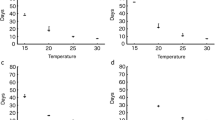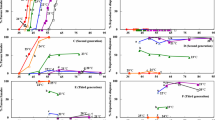Abstract
The wandering glider dragonfly, Pantala flavescens (Fabricius), arrives in Japan from tropical regions every spring. The offspring colonize areas throughout Japan, with rapid increases in populations in the autumn, but all individuals die in the winter, suggesting low tolerance to low temperatures. However, few quantitative data on egg development and water temperature have been reported for this species. Females at the reproductive stage were collected from fields throughout the flying season and their eggs released using an artificial oviposition technique. Almost all of the eggs were fertilized. Egg size was stable throughout the seasons. Most eggs hatched within a period of 5 days at high water temperatures (35 and 30 °C), which were recorded in the shallow ponds and rice paddy fields from summer to early autumn. However, the egg-stage duration increased with declining water temperature. All eggs in water at 15 °C had failed to hatch by 90 days. The calculated critical temperature of water was determined to be approximately 14.3 °C; the total effective temperature for the egg stage was about 80 degree-days. Thus, low water temperatures in winter may prevent P. flavescens overwintering in Japan.




Similar content being viewed by others
References
Arai Y (1991) On the drought and cold resistance of Pantala flavescens larvae. Gracile 45:15–22 (in Japanese)
Arai Y (2007) The mystery of red dragonflies. Doubutsu-sha, Tokyo (in Japanese)
Arai Y (2012) Some ecological observations of Pantala flavescens (Fabricius) in Kanto District. Gracile 72:32–39 (in Japanese with English summary)
Bennett S, Mill PJ (1995) Lifetime egg production and egg mortality in the damselfly Pyrrhosoma nymphula (Sulzer) (Zygoptera: Coenagrionidae). Hydrobiologia 310:71–78
Corbet PS (1999) Dragonflies: bhavior and ecology of Odonata. Cornell University Press, Ithaca
Douma A, Harada M, Hiramatsu K, Marui A (2010) Dynamic analysis of chlorophyll-a and nutrients in eutrophic reservoirs by using a water quality model based on species composition of algae. Sci B Fac Agric Kyushu 65:73–89 (in Japanese with English summary)
Gribbin SD, Thompson DJ (1990) Egg size and clutch size in Pyrrhosoma nymphula (Sulzer) (Zygoptera: Coenagrionidae). Odonatologica 19:347–357
Hawking JH, Ingram BA (1994) Rate of larval development of Pantala flavescens (Fabricius) at its southern limit of range in Australia (Anisoptera: Libellulidae). Odonatologica 23:63–68
Hirake T (2012) Marking and flight observation of Pantala flavescens. Gracile 72:42–47 (in Japanese)
Ichikawa Y, Watanabe M (2014) Changes in the number of eggs loaded in Pantala flavescens females with age from mass flights (Odonata: Libellulidae). Zool Sci 31:721–724
Ichikawa Y, Watanabe M (2015) The daily food intake of Pantala flavescens females from foraging swarms estimated by the faeces excreted (Odonata: Libellulidae). Odonatologica 44:375–389
Ichikawa Y, Watanabe M (2016) Daily egg production in Pantala flavescens in relation to food intake (Odonata: Libellulidae). Odonatologica 45:107–116
Inoue K, Tani K (1999) All about dragonflies. TOMBOW, Osaka (in Japanese)
Inoue K, Tani K (2010) All about red dragonflies. TOMBOW, Osaka (in Japanese)
Ishizawa N (2007) Morphological variations in relation to maturation in Pantala flavescens (Fabricius) in central Japan (Anisoptera: Libellulidae). Odonatologica 36:147–157
Iwata N, Akieda N, Hirai N, Ishii M (2009) Seasonal prevalence of the migratory dragonfly, Pantala flavescens (Anisoptera, Libellulidae), in Sakai City, Osaka Prefecture, central Japan. Tombo 51:29–37 (in Japanese with English summary)
Kanao S, Ohtsuka T, Maehata M, Suzuki N, Sawada H (2009) Effectiveness of paddy fields as an initial growth environment for larval and Juvenile nigorobuna Carassius auratus grandoculis. Nippon Suisan Gakkaishi 75:191–197 (in Japanese with English summary)
Kiritani K (1997) The low development threshold temperature and the thermal constant in insects, mites and nematodes in Japan. Misc Publ NIAS 21 (in Japanese with English summary)
Kudou S (2012) Alien fish problems in Hokkaido (largemouth, smallmouth bass and bluegill as invasive alien species). Nippon Suisan Gakkaishi 78:983–987 (in Japanese)
Lutz PE, Rogers A (1991) Thermal effects on embryonic development in four summer species of Libellulidae (Anisoptera). Odonatologica 20:281–292
Pilon J-G, Pilon L, Lagacé D (1989) Notes on the effect of temperature on egg development of Leucorrhinia glacialis Hagen (Anisoptera: Libellulidae). Odonatologica 18:293–296
Punzo F (1988) Effects of low environmental pH and temperature on hatching and metabolic rates in embryos of Anax junius Drury (Odonata: Aeshnidae) and the role of hypoxia in the hatching process. Comp Biochem Phys 91:333–336
Schenk K, Suhling F, Martens A (2004) Egg distribution, mate-guarding intensity and offspring characteristics in dragonflies (Odonata). Anim Behav 68:599–606
Siva-Jothy MT, Gibbons DW, Pain D (1995) Female oviposition-site preference and egg hatching success in the damselfly Calopteryx splendens xanthostoma. Behav Ecol Sociobiol 37:39–44
Soeffing K (1986) Ecological studies on eggs and larvae of Leucorrhinia rubicunda (L.) (Odonata, Libellulidae). Jber ForschInst Borstel 1986:234–237
Sternberg K (1995) Influence of oviposition date and temperature upon embryonic development in Somatochlora alpestris and S. arctica (Odonata: Corduliidae). J Zool 235:163–174
Tachibana D, Yakushiji K (2012) Influence of a biotope built in the metropolitan on the animals which appeared, and problems which the biotope holds now. AIJ J Technol Des 18:391–396 (in Japanese with English summary)
Troast D, Suhling F, Jinguji H, Sahlén G, Ware J (2016) A global population genetic study of Pantala flavescens. PLoS One 11:e0148949. doi:10.1371/journal.pone.0148949
Watanabe M (1999) Basic research on the Odonata larvae as a teaching material from the swimming pool of elementary and junior high schools. Jpn J Biol Educ 39:65–76 (in Japanese with English summary)
Watanabe M (2015) Ecology of Odonata. University of Tokyo Press (in Japanese)
Watanabe M, Adachi Y (1987) Fecundity and oviposition pattern in the damselfly Copera annulata (Selys) (Zygoptera: Platycnemididae). Odonatologica 16:85–92
Watanabe M, Kato K (2012) Oviposition behaviour in the dragonfly Sympetrum infuscatum (Selys) mistaking dried-up rice paddy fields as suitable oviposition sites (Anisoptera: Libellulidae). Odonatologica 41:151–160
Watanabe M, Suda D, Iwasaki H (2011) The number of eggs developed in the ovaries of the dragonfly Sympetrum infuscatum (Selys) in relation to daily food intake in forest gaps (Anisoptera: Libellulidae). Odonatologica 40:317–325
Acknowledgments
We would like to thank Mr. T. Konagaya and Mr. G. Takahashi for helping to rear the eggs.
Author information
Authors and Affiliations
Corresponding author
Rights and permissions
About this article
Cite this article
Ichikawa, Y., Yokoi, T. & Watanabe, M. Thermal factors affecting egg development in the wandering glider dragonfly, Pantala flavescens (Odonata: Libellulidae). Appl Entomol Zool 52, 89–95 (2017). https://doi.org/10.1007/s13355-016-0457-9
Received:
Accepted:
Published:
Issue Date:
DOI: https://doi.org/10.1007/s13355-016-0457-9




